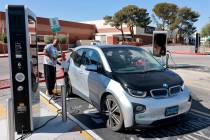Electricity, natural gas lead fuel revolution
The Las Vegas Regional Clean Cities Coalition and the Alternative Fuel Vehicles Institute recently joined forces to host a one-day workshop, entitled "The A to Z of AFVs."
The discussion panel provided encouraging news about the growing availability of replacement fuels that, working in combination, could help change U.S. reliance on imported crude oil to fuel its economy.
U.S. citizens comprise about 4 percent of the world's population, yet consume about 22 percent of the world's crude oil supply on a daily basis. This creates long term geopolitical, economic and environmental problems for the United States and the world if the primary source of transportation fuel for every nation is based on crude oil.
In 2008, the U.S. imported 70 percent of its crude oil needs by paying out $700 billion to overseas producers. As a comparative reference, Travis Johnson of NV Energy stated that the U.S. federal government had a budget of $2.9 trillion that year to run the entire country. What if the money being sent overseas to purchase crude oil could be reinvested into the U.S. economy?
In Southern Nevada, the electrical grid receives electricity from a relatively clean array of power generation plants. About 71 percent of the electrical energy comes from power plants burning natural gas, 17 percent comes from coal and renewable energy and other sources make up the remaining 12 percent. The Southern Nevada electric system will peak at about 5,500 megawatts of total power consumption on a daily basis, and about 2,000 megawatts will likely be available each night during nonpeak hours. Johnson projected that this excess electricity could be used to recharge 1 million GM Chevy Volt plug-in hybrid electric vehicles without making significant changes to the existing state electrical grid infrastructure. By late 2010 in Northern Nevada, nearly half the energy available at night will be from geothermal sources and there will be ample capacity to charge a quarter million GM Chevy Volts (or equivalents).
Given that the state's total population is under 3 million, there is a lot of potential room to grow a robust electric vehicle transportation industry that would significantly improve the state's economy. At an equivalent price of 70 cents per gallon for electrical energy (winter off-peak EV rate), it is simply a matter of time before this will happen.
The international automotive industry is ready to comply. During the recent Frankfurt Auto Show in Germany last month, industry analysts projected that international automobile manufacturers will be producing at least 200 different models of vehicles for consumers that have hybrid electric, plug-in hybrid electric or pure battery-powered electric drivetrains by 2014.
Although electric vehicles powered by clean renewable energy are perceived as the best way for consumers to help resolve transportation problems, the limitations of battery range and recharging infrastructure will still take time to overcome during the next five years by the automotive industry, electric utilities and local governments. These engineering problems become even more difficult to resolve with heavy-duty vehicles, such as the national trucking fleet or public transit buses. Ethanol, biodiesel and natural gas are perceived as shorter term "bridge fuels" that offer a cleaner burning internal combustion engine technology than gasoline, yet still retain similar range, power density and distribution infrastructure.
Natural gas, in either a compressed or liquid form, can be a very strong player in this new alternative fuel marketplace to provide sufficient power for heavy-duty vehicles.
During the Clean Energy Summit 2.0 staged at the UNLV campus in August, Sen. Harry Reid invited Oklahoma billionaire T. Boone Pickens to participate with former Vice President Al Gore in a round table discussion and a town hall meeting. These former political rivals have found common ground in their joint crusade to wean the U.S. off its addiction to imported crude oil.
The Pickens Plan is based on newly discovered reserves of natural gas within the United States that can be extracted from carbon shale deposits. If the price of a barrel of crude oil once again starts to climb to the $100 mark, it will make the cost of extracting natural gas from carbon shale more competitive. The U.S. Energy Information Administration estimates that this country has approximately 1,770 trillion cubic feet of technically recoverable natural gas with 238 trillion cubic feet of proven reserves. At current production rates, these reserves could provide transportation power to the U.S. for the next 90 years.
Locally, the MGM Mirage Corp. is betting on this technology with its new City Center development that will begin opening in Las Vegas during the next few months. As part of its business practices to achieve a Silver or Gold LEED certification from the U.S. Green Building Council, the company will maintain a fleet of stretch limousines that run on compressed natural gas. The original fleet will begin with 26 silver Lincoln Town Cars. Additional fleet capacity will be added over the next few years for an expected total of 100 vehicles. Guests arriving at City Center in alternative fuel vehicles will have access to preferred parking spaces.
Stan Hanel has worked in the electronics industry for more than 30 years and is a long-time member of the Electric Auto Association and the Las Vegas Electric Vehicle Association. Hanel writes and edits for EAA's "Current Events" and LVEVA's "Watts Happening" newletters. Contact him at stanhanel@aol.com.

















